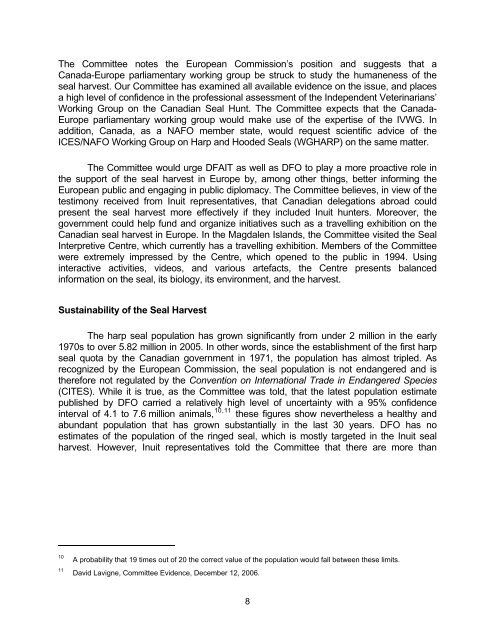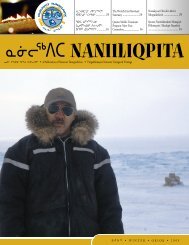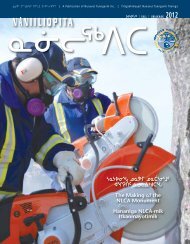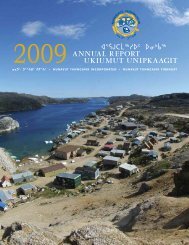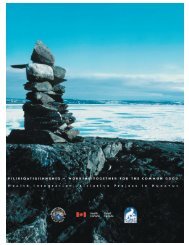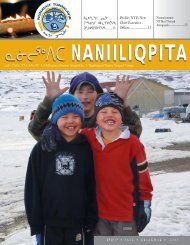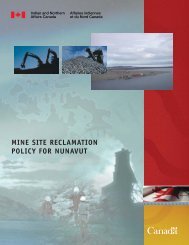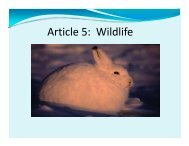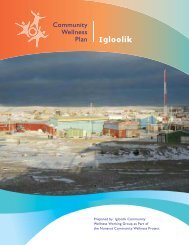The Committee notes the European Commission’s position <strong>and</strong> suggests that aCanada-Europe parliamentary working group be struck to study the humaneness of theseal harvest. Our Committee has examined all available evidence on the issue, <strong>and</strong> placesa high level of confidence in the professional assessment of the Independent Veterinarians’Working Group on the Canadian <strong>Seal</strong> Hunt. The Committee expects that the Canada-Europe parliamentary working group would make use of the expertise of the IVWG. Inaddition, Canada, as a NAFO member state, would request scientific advice of theICES/NAFO Working Group on Harp <strong>and</strong> Hooded <strong>Seal</strong>s (WGHARP) on the same matter.The Committee would urge DFAIT as well as DFO to play a more proactive role inthe support of the seal harvest in Europe by, among other things, better informing theEuropean public <strong>and</strong> engaging in public diplomacy. The Committee believes, in view of thetestimony received from Inuit representatives, that Canadian delegations abroad couldpresent the seal harvest more effectively if they included Inuit hunters. Moreover, thegovernment could help fund <strong>and</strong> organize initiatives such as a travelling exhibition on theCanadian seal harvest in Europe. In the Magdalen Isl<strong>and</strong>s, the Committee visited the <strong>Seal</strong>Interpretive Centre, which currently has a travelling exhibition. Members of the Committeewere extremely impressed by the Centre, which opened to the public in 1994. Usinginteractive activities, videos, <strong>and</strong> various artefacts, the Centre presents balancedinformation on the seal, its biology, its environment, <strong>and</strong> the harvest.Sustainability of the <strong>Seal</strong> <strong>Harvest</strong>The harp seal population has grown significantly from under 2 million in the early1970s to over 5.82 million in 2005. In other words, since the establishment of the first harpseal quota by the Canadian government in 1971, the population has almost tripled. Asrecognized by the European Commission, the seal population is not endangered <strong>and</strong> istherefore not regulated by the Convention on International Trade in Endangered Species(CITES). While it is true, as the Committee was told, that the latest population estimatepublished by DFO carried a relatively high level of uncertainty with a 95% confidenceinterval of 4.1 to 7.6 million animals, 10,11 these figures show nevertheless a healthy <strong>and</strong>abundant population that has grown substantially in the last 30 years. DFO has noestimates of the population of the ringed seal, which is mostly targeted in the Inuit sealharvest. However, Inuit representatives told the Committee that there are more than1011A probability that 19 times out of 20 the correct value of the population would fall between these limits.David Lavigne, Committee Evidence, December 12, 2006.8
2 million ringed seals in <strong>Nunavut</strong>. In 1996, the Scientific Committee of the North AtlanticMarine Mammal Commission (NAMMCO) “derived a rough estimate of the abundance ofringed seals in Area 1 of approximately 1.3 million seals, based on extending existingestimates to areas of similar habitat.” 12After the European ban, harvest off the East coast had declined to less than 20,000in 1985, <strong>and</strong> consistently remained below 70,000 until 1995. The Committee believes thatthe limited harvest of harp seals between 1983 <strong>and</strong> 1995 contributed to the increase in thesize of the population. This rapid growth of the harp seal population has allowed significantincreases in quotas set by DFO <strong>and</strong>, as a result, in the annual harvest of harp seals.Annual catches have been above 200,000 for every year since 1996, with the exception of2000. In 2005, reported catches for “the Gulf” <strong>and</strong> “the Front” were at 324,000, <strong>and</strong> totalcatches for the Northwest Atlantic (including Greenl<strong>and</strong>) were at almost 395,000.The Committee believes however that the increases in current annual harvestshave led to a stabilization of the harp seal population, not a reduction. With quotas basedon sound conservation principles, the Canadian seal harvest is sustainable. DFO adoptedan Objective Based Fisheries Management (OBFM) approach to the management of theharp seal for the 2003-2005 <strong>Seal</strong> Management Plan as recommended by the EminentPanel on <strong>Seal</strong> Management in 2001. 13 The OBFM approach uses reference points <strong>and</strong>control rules to establish management measures for a fishery. The approach is designed insuch a way that there is an 80% probability that the harp seal population does not fallbelow 70% of the largest observed population (also known as the N70 level). Moreimportantly, DFO’s current approach dictates that conservation management measures,including significant reductions in the TAC, be implemented to bring back <strong>and</strong> maintain theseal population above 4.1 million animals (70% of 5.82 million), in the event that thepopulation fall below that threshold. DFO will continue to use this approach for themanagement of the harp seal population for the years 2006 to 2010. One expert witnesstold the Committee that “the Canadian harp seal population is arguably among the bestmanagedpopulations of wild animals in the world.” 14 Moreover, the Atlantic <strong>Seal</strong> Forum,held November 2005, to which more than 200 organizations from industry, government,aboriginal, conservation <strong>and</strong> animal rights groups were invited to provide their input on theproposed management regime, endorsed the OBFM approach. 15121314NAMMCO, Status of Marine Mammals in the North Atlantic: the Ringed <strong>Seal</strong>, Tromsø, Norway, p. 3,http://www.nammco.no/webcronize/images/Nammco/653.pdf. NAMMCO, “Report of the Scientific Committee”, InNAMMCO, Annual Report 1996, Tromsø, Norway, 1997, pp.97-178. The geographical Area 1 is defined as BaffinBay, Davis Strait, eastern Hudson Strait, Labrador Sea, Lancaster, Jones <strong>and</strong> Smith sounds.Ian McLaren, Solange Brault, John Harwood, <strong>and</strong> David Vardy, Report of the Eminent Panel on <strong>Seal</strong> Management,2001, available athttp://www.dfo-mpo.gc.ca/seal-phoque/reports-rapports/expert/repsm-rgegp_e.htm.Alice Crook, Committee Evidence, October 5, 2006.15 Department of Fisheries <strong>and</strong> Oceans, Technical Briefing on the Canadian <strong>Seal</strong> Hunt, March 15, 2006, available athttp://www.dfo-mpo.gc.ca/media/infocus/2006/seals/2006seal_briefing_e.htm.9


